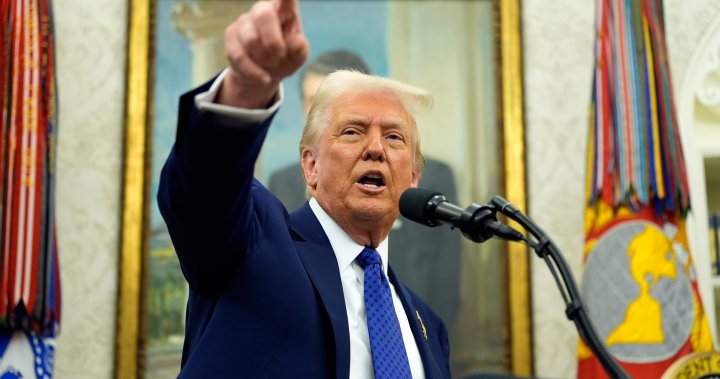Canada
Trump set to impose sweeping reciprocal tariffs within hours: ‘The big one’

Reciprocal Tariffs: Understanding Trump’s Latest Trade Policy
Donald Trump, the former U.S. President, made headlines again with his announcement to impose reciprocal tariffs on foreign imports. In a post on his Truth Social platform, Trump revealed that he would be holding a news conference at the Oval Office to discuss the details of this new trade policy. The announcement, made earlier in the day, was teased as a "big one," suggesting that the move would have significant implications for U.S. trade relations. Trump’s decision to impose these tariffs is part of his broader "America First" agenda, which he believes will help restore the country’s economic strength.
The Tariffs: A Closer Look
On Monday, Trump signed two executive orders that will impose a 25% tariff on foreign steel and aluminum, effective March 12. Unlike previous trade policies, these tariffs will apply universally, without exemptions for any country. This move is seen as a bold step by the former president, who has long criticized what he calls unfair trade practices by other nations. "It’s a big deal," Trump said during the signing ceremony in the Oval Office. "This is the beginning of making America rich again." The tariffs are intended to protect American industries, particularly the steel and aluminum sectors, which Trump argues have been harmed by cheaper foreign imports.
International Reactions: Condemnation and Retaliation
The announcement of these tariffs has sparked widespread condemnation from some of the United States’ closest trading partners, including Canada. Many of these countries have expressed concerns that the tariffs will disrupt global trade flows and lead to retaliatory measures. For instance, Canada, which has traditionally enjoyed a strong trade relationship with the U.S., has threatened to impose its own retaliatory tariffs if the U.S. proceeds with the plan. Prime Minister Justin Trudeau has stated that Canada will craft these tariffs in a way that minimizes harm to Canadian consumers while maximizing the impact on American goods.
What Are Reciprocal Tariffs?
The term "reciprocal tariffs" has become a buzzword in recent weeks, but its exact meaning remains unclear. Trump has not provided a detailed definition of what he considers "reciprocal," leaving room for interpretation. Broadly speaking, reciprocal tariffs appear to be designed to mirror the tariffs imposed by other countries on American goods. For example, if a foreign country imposes a 10% tariff on U.S.-made cars, the U.S. might retaliate by imposing a 10% tariff on cars imported from that country. This approach is different from what is often referred to as "retaliatory tariffs," which are typically imposed in response to new trade restrictions.
The Difference Between Reciprocal and Retaliatory Tariffs
While reciprocal and retaliatory tariffs are often used interchangeably, there is a subtle distinction between the two. Reciprocal tariffs are generally aimed at matching the tariffs imposed by other countries, either in value or in spirit. This approach is seen as a way to level the playing field and ensure fair trade practices. On the other hand, retaliatory tariffs are more punitive in nature and are usually imposed as a direct response to tariffs or other trade barriers enacted by another country. For instance, if the U.S. imposes tariffs on Canadian steel, Canada might retaliate by imposing tariffs on American goods such as bourbon or Harley-Davidson motorcycles.
The Broader Implications of Trump’s Tariff Policy
The implementation of these tariffs has significant implications for the global economy. While Trump and his supporters argue that the tariffs will help protect American industries and create jobs, critics warn that they could lead to a trade war, causing prices to rise and hurting consumers. Additionally, the uncertainty surrounding the definition of "reciprocal" has left many questions unanswered. Will the tariffs apply only to countries that already have tariffs in place on American goods, or will they also target countries with non-tariff barriers, such as regulatory hurdles? The answers to these questions will play a crucial role in determining the impact of Trump’s latest trade policy.
As the U.S. moves forward with these tariffs, the world will be watching closely to see how other countries respond. Will they match the tariffs dollar for dollar, or will they take a more measured approach? The outcome of this high-stakes game of trade policy will have far-reaching consequences, not just for the U.S. and its trading partners, but for the global economy as a whole. One thing is certain: the era of "America First" is reshaping the rules of international trade, and the world will need to adapt quickly to keep up.











